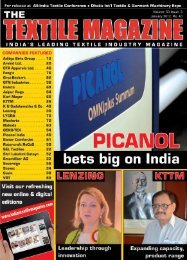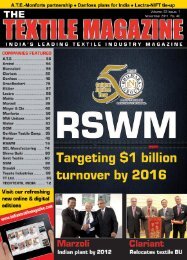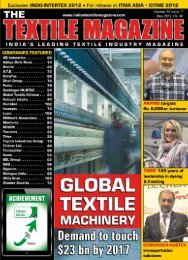00 ItMa 2011 (exclusive Feature) - Textile Magazine
00 ItMa 2011 (exclusive Feature) - Textile Magazine
00 ItMa 2011 (exclusive Feature) - Textile Magazine
Create successful ePaper yourself
Turn your PDF publications into a flip-book with our unique Google optimized e-Paper software.
itMA <strong>2011</strong> [<strong>exclusive</strong> feature]<br />
tured <strong>exclusive</strong>ly on braiding machines.<br />
However, using MultiSphere<br />
technology ropes, with or without<br />
cores, as well as twine and cord,<br />
etc., can now be woven on both the<br />
NC2M and the electronically controlled<br />
NH2M narrow fabric needle<br />
loom. These machines are designed<br />
for a variety of rope diameters and<br />
differ from their conventional counterparts<br />
with regard to reed, fabric<br />
guide and take-off design.<br />
Sheath and core thread insertion<br />
takes place via a compensation device,<br />
which also supports the formation<br />
of a three-dimensional structure.<br />
As opposed to standard rope<br />
braiding systems, the new process<br />
stands out due to the advantages like<br />
higher productivity, longer, knotfree<br />
items due to the extended yarn<br />
lengths available on the bobbins/<br />
warp beams as compared to braiding<br />
bobbins, and far lower production<br />
and manufacturing costs.<br />
Warp knitting with weft insertion<br />
For a number of years, direct<br />
drives using linear and servomotors<br />
have played an increasingly important<br />
role in the design of Jakob<br />
Müller AG narrow fabric looms and<br />
knitting machines. Consequently,<br />
the new MDC (Müller Direct Crochet)<br />
is now available in three versions:<br />
• The electronically-controlled<br />
MDC 8/630 with a working width of<br />
630 mm and a maximum of 8 weft<br />
bars<br />
• The electronically-controlled<br />
MDC 3/830E with a working width<br />
of 830 mm, 2 longitudinal bars with<br />
a maximum stroke of 450 mm, a<br />
rubber rod and a part weft bar with a<br />
maximum stroke of 25 mm<br />
106 | ThE TEXTILE MAGAZINE OCTOBER <strong>2011</strong><br />
• The mechanically-controlled<br />
MDC 3/830M with a working width<br />
of 830 mm and three weft bars for<br />
simple designs<br />
The electronically-controlled weft<br />
bars offer great design variety, quick<br />
article changes and endless repeat<br />
lengths. The machine speed can be<br />
adjusted to the stroke required by<br />
the pattern, i.e., the product characteristics.<br />
Article patterns can be fed in directly<br />
via the MDC C2<strong>00</strong> control<br />
module, or as an alternative, MÜ-<br />
CARD2 pattern design software is<br />
available.<br />
The product range of the MDC<br />
3/830E is extremely wide and extends<br />
from technical applications to<br />
underwear items in both elastic and<br />
non-elastic variations. In addition,<br />
the use of differing types of needle<br />
facilitates the utilisation of a diversity<br />
of yarn qualities that includes<br />
natural and synthetic fibres with 20<br />
to 3,<strong>00</strong>0 dtex.<br />
Inkjet direct printing<br />
system<br />
The MDP2, which was launched<br />
some two years ago for the printing<br />
of non-elastic narrow fabrics and<br />
belts, is now available in a slightly<br />
modified form as the MDP2 E for<br />
the contactless ink jet printing of<br />
elastic and non-elastic narrow fabrics<br />
and belts. The machine operates<br />
from roll to roll, from crate to crate<br />
and from roll to crate and vice versa.<br />
The widths processed may amount<br />
to as much as 4<strong>00</strong> mm and in the<br />
case of narrower items, i.e., with a<br />
minimum width of 15 mm, 16 narrow<br />
fabrics can be printed during<br />
parallel running. A minimum gap of<br />
10 mm between the fabrics is nec-<br />
essary. The contactless process permits<br />
the printing of relatively heavy<br />
and thick products with coarse surface<br />
structures.<br />
Universal warping<br />
machine<br />
The new SMA-4<strong>00</strong> warping machine<br />
permits the processing of<br />
warp beams with maximum disc<br />
diameters and width dimensions<br />
of up to 4<strong>00</strong> mm. The machine is<br />
fitted with a simple control system<br />
and by employing a combination of<br />
a creel for unrolling elastic threads<br />
and a pre-stretcher, users can warp<br />
highly elastic yarns containing latex<br />
threads and crepe, synthetic elastomers,<br />
single- or double-wound<br />
rubber thread and non-elastic yarns<br />
with a maximum of 3,<strong>00</strong>0 dtex.<br />
The MFR 3C is a modular design<br />
line for the continuous dyeing and/<br />
or finishing of several parallel running<br />
narrow fabrics across a working<br />
width of 30 cm. The line is fitted with<br />
an efficient thermosol/steam oven,<br />
which ensures absolutely uniform<br />
temperature distribution throughout<br />
the entire fixing chamber.<br />
The MFR 3C is capable of processing<br />
light- to medium-weight, elastic<br />
and non-elastic polyamide, cotton<br />
and polyester narrow fabrics at a<br />
maximum working speed of up to<br />
30 m/min. The machine is designed<br />
for small series and medium-sized<br />
production batches.<br />
A feed unit, a padding machine,<br />
infra-red dryer, thermosol, steam or<br />
combi (thermosol/steam) fixing ovens,<br />
washing tanks, 10-cylinder driers<br />
and a take-off unit are available<br />
to Müller customers as modules for<br />
optimum dyeing and finishing quality.<br />
w






